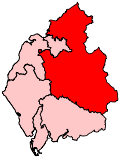History of boundaries

Map of boundaries 2010–2024
1950–1983: The Urban District of Penrith, and the Rural Districts of Alston with Garrigill, Border, Penrith, and Wigton.
1983–1997: The District of Eden wards of Alston Moor, Appleby, Appleby Bongate, Askham, Brough, Crosby Ravensworth, Dacre, Eamont, Greystoke, Hartside, Hesket, Kirkby Thore, Kirkoswald, Langwathby, Lazonby, Long Marton, Lowther, Penrith East, Penrith North, Penrith South, Penrith West, Skelton, Ullswater, and Warcop, the City of Carlisle wards of Arthuret, Brampton, Burgh, Dalston, Great Corby and Geltsdale, Hayton, Irthing, Lyne, St Cuthbert Without, Stanwix Rural, and Wetheral, and the District of Allerdale wards of Aspatria, Boltons, Marsh, Silloth, Tarns, Wampool, Warnell, Waver, and Wigton.
1997–2010: The District of Eden, the City of Carlisle wards of Arthuret, Brampton, Great Corby and Geltsdale, Hayton, Irthing, Lyne, Stanwix Rural, and Wetheral, and the District of Allerdale wards of Marsh, Wampool, Warnell, and Wigton.
2010–2024: The District of Eden, the City of Carlisle wards of Brampton, Great Corby and Geltsdale, Hayton, Irthing, Longtown and Rockcliffe, Lyne, and Stanwix Rural, and the District of Allerdale wards of Warnell and Wigton.
The constituency was created in 1950 by merging part of Penrith and Cockermouth with North Cumberland. It was redrawn in 1983 by taking in most of the northern part of the old Westmorland constituency and in 1997 by taking in the Kirkby Stephen and Tebay areas of the pre-1997 Westmorland and Lonsdale constituency by doing so the constituency covered the entire district of Eden. Penrith and The Border also included parts of Allerdale and Carlisle districts, but lost parts of these areas to other seats at each boundary review.
Penrith and The Border was the largest constituency by area in England until 2024. Despite the name, it only included the Cumbrian portion of the English border with Scotland. The Northumberland portion was covered by the constituencies of Hexham and Berwick-upon-Tweed. The name stems from the fact that when the constituency was first created it consisted of the Penrith Rural and Urban Districts, the Border Rural District and also the Alston with Garrigill Rural District.


